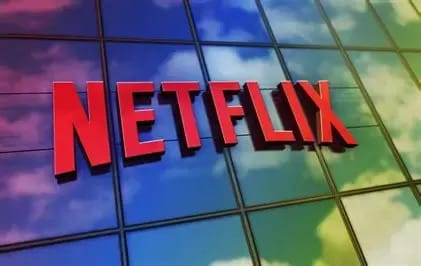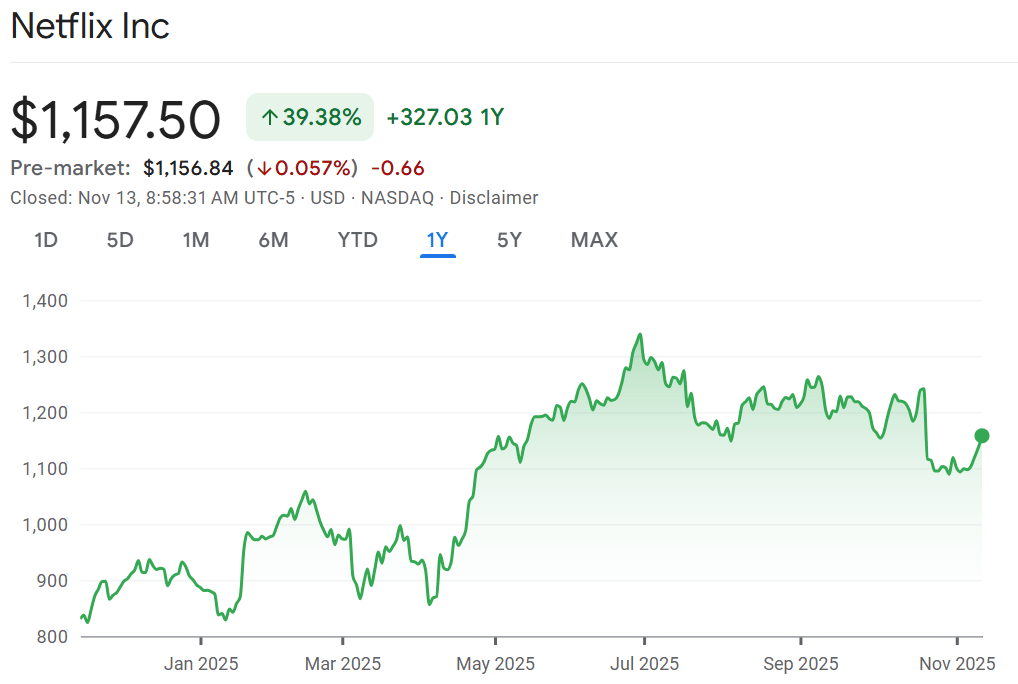- The Pragmatic Investor
- Posts
- Pragmatic Friday: ⚡The Netflix Reset - 10-For-1 Split, One Massive Opportunity
Pragmatic Friday: ⚡The Netflix Reset - 10-For-1 Split, One Massive Opportunity

🌞 Good Morning, Pragmatic Thinkers!
The market spent the week obsessing over headlines that didn’t matter and completely ignored the signals that did. Everyone got caught up in the drama — the noise, the hot takes, the surface-level reactions — while the real story sat quietly underneath. And here’s the uncomfortable truth: when investors chase headlines instead of fundamentals, they set themselves up to miss the moment when the real shift begins.
This week was a perfect example. The crowd fixated on the “excitement” around a 10-for-1 split at Netflix, as if a corporate action alone writes the next chapter. But the split wasn’t the story. The reaction was. The price pulling back to the 200-day EMA was. The tension between soft expectations and strong long-term positioning was. The way sentiment and structure clashed right under everyone’s nose was.
What actually mattered wasn’t the hype. It was the reset — technical, psychological, and structural — happening beneath the surface. Because when a market darling cools off at the exact moment its business model gets sharper, clearer and more monetisable… that’s not a warning. That’s an invitation.
So today’s Pragmatic Playbook tears past the headline confetti and gets straight to the part investors need to understand: what Netflix is really doing, what its latest earnings reveal, and why this pullback isn’t fear — it’s opportunity disguised as hesitation. This is where investors either freeze… or get focused.
Let’s get into it.
🔥 Market Pulse – What Actually Mattered This Week
The U.S. government shutdown ended after the House voted to send a funding bill to the President, but not without major economic and political scars. The cost? Delayed economic data, shaken confidence and an ecosystem used to certainty now facing disruption. That risk filters into markets faster than most bullish narratives assume—ignore it and you’re betting on rhythm when the beat’s been skipped.
Wall Street is looking at Palantir and Alphabet and drawing a line in the sand: one is seen as over-priced, the other as the better AI bet. The signal here: leadership is shifting, capital is repositioning, and sticking with yesterday’s marquee names may cost you. If you’re not paying attention to who the smart money is backing now, you're investing in someone else’s story.
Robinhood’s new service to deliver physical cash to customers’ doors via delivery app isn’t just quirky—it’s a glimpse into how financial services are adapting—and possibly weakening—from the traditional banking model. When convenience becomes the sales pitch, underlying value might be leaking. This sets a tone for risk assets too: when innovation markets the same old services differently, the real value shift is hidden.
TOGETHER WITH OUR PARTNER
Don’t get SaaD. Get Rippling.
Remember when software made business simpler?
Today, the average company runs 100+ apps—each with its own logins, data, and headaches. HR can’t find employee info. IT fights security blind spots. Finance reconciles numbers instead of planning growth.
Our State of Software Sprawl report reveals the true cost of “Software as a Disservice” (SaaD)—and how much time, money, and sanity it’s draining from your teams.
The future of work is unified. Don’t get SaaD. Get Rippling.
🎯 The Pragmatic Playbook: Netflix Reset - The Split, The Slide, The Setup

The Market Thinks This Is Just a Pullback. It Isn’t.
There’s a weird energy around Netflix right now. A 10-for-1 stock split should feel like a celebration, but instead it has landed right on top of a sudden price slide back toward the 200-day EMA. Most retail investors are shrugging this off as “just volatility.” But here’s the truth they’re ignoring:
Splits aren’t about excitement. They’re about positioning.
Pullbacks aren’t about weakness. They’re about opportunity.
And when both happen at the same time — you either pay attention, or you miss the moment entirely.
Netflix isn’t collapsing. It’s resetting. And resets are where serious money is made.
Not from hype. Not from headlines. But from understanding the structural setup sitting right in front of you.
This isn’t another “tech giant wobbling after earnings” story. This is a business with real volume, real cash flow, real pricing power — stepping into its next evolution while the market tries to price the transition in real time.
If you’re reading this expecting a feel-good narrative, stop here.
If you want a clear, unfiltered breakdown of where Netflix actually stands — and what smart investors should be thinking — let’s get into it.
🎥 The Numbers Don’t Lie — They Just Need Interpreting
Netflix delivered revenue of $11.51 billion, up roughly 17% year-over-year. That alone tells you the business is far from slowing down. In this market, double-digit top-line growth for a company of Netflix’s size is rare. And yet, the stock still slid.
Why?
Because EPS came in at $5.87, missing expectations.
But here’s what the headlines conveniently forget to emphasise:
A one-time tax hit in Brazil carved out hundreds of millions from the bottom line.
Not recurring. Not structural. Not a sign of a dying margin profile.
Investors love to overreact when they see a miss — even if the miss isn’t from the business itself. It’s emotional. It’s lazy. And that’s how discounts get created.
Strip away the noise and look at what actually matters:
Revenue still climbing double digits
Subscriber base stabilising
Global expansion accelerating
Ad-tier revenue expanding faster than expected
Content spend getting smarter, not larger
But the real gem?
Netflix is growing without needing to burn cash to do it.
That’s the kind of business you want heading into a potentially choppy 2026 macro cycle.
And yet, because traders saw a red candle, they instantly assumed weakness.
Wrong.
This is where conviction is built — not destroyed.
📉 The Technical Picture Is Cleaner Than It Looks
Here’s the part that most people won’t see unless they zoom out:
Netflix has come back to its 200-day EMA — and it hasn’t touched this level in months.
This is where long-duration buyers tend to re-enter.
Funds like to load at the 200-day EMA.
Retail tends to panic at the 200-day EMA.
You decide which one you want to be.
This level doesn’t guarantee a bounce. Nothing does. But what it does offer is a point of clarity:
If Netflix holds this level and begins to climb, conviction money comes in.
If Netflix slices through this level with heavy volume, you wait for structure.
Either way, indecision becomes strategy.
Right now, Netflix isn't breaking down.
It’s pulling back into strength.
And with a stock split around the corner, this is exactly the kind of technical reset that often precedes strong moves — not because of magic, but because of psychology.
Cheaper-looking shares invite more buyers.
More buyers strengthen volume.
Volume builds conviction.
Conviction builds trend.
If you’ve been waiting for a moment where price and fundamentals align, this is the closest you’ve had in months.
🔟 The 10-for-1 Split: More Than a Vanity Move
Let’s be brutally honest: stock splits don’t change intrinsic value.
They don’t make a business “better.”
They don’t guarantee returns.
But they do something Wall Street never talks about directly:
They rebuild liquidity.
They reset sentiment.
They unlock new participants.
At roughly $1,150 per share, Netflix has priced out a huge chunk of retail investors.
After the split?
You’re looking at something closer to $110 — psychologically accessible, portfolio-friendly, and algorithmically attractive.
Splits affect:
1. Order Flow
Lower share price → more activity → tighter spreads → stronger trend signals.
2. Retail Participation
Retail buyers matter more than people admit. Their constant inflow supports momentum.
3. Behavioral Anchoring
A $1,100 stock “feels expensive.”
A $110 stock “feels reasonable.”
Even if they’re the same thing.
These mental shortcuts move markets all the time. And Netflix knows exactly how to time them.
Management didn’t announce this split by accident.
They announced it because they see a new phase coming — and they want the stock positioned for it.
When CEOs are unsure, they buy time.
When CEOs are confident, they prepare the market.
Read that again.
🌍 What’s Really Powering Netflix Right Now
Let’s get under the hood and talk about the stuff that actually moves long-term value:
1. Advertising Isn’t a Side Project Anymore
Netflix’s ad-tier business is scaling faster than expected.
This is recurring.
This is high-margin.
This is strategic.
If this trajectory holds, Netflix becomes more than a subscription platform — it becomes a hybrid content + ad engine, similar to YouTube but with premium pricing power.
2. Global Markets Are Carrying More Weight
Growth outside the U.S. is no longer a “bonus.”
It’s becoming a primary driver.
Emerging markets are improving ARPU.
Local content is succeeding.
Cost structures are stabilising.
This matters because it smooths the earnings curve — less dependency on one geography means more room for sustainable compounding.
3. Content Strategy Is Getting Sharper
Fewer massive bets.
More targeted hits.
More live experiences.
More interactive formats.
Netflix isn’t just making shows anymore — it’s building engagement layers.
The more layers you add, the harder it becomes for subscribers to churn.
4. Margins Will Rebound
The Brazil tax hit was ugly. But temporary.
Margins excluding the anomaly remain stable.
When margins stabilise + ad revenue grows + global expansion speeds up…
You don’t need a spreadsheet to understand what comes next.
⚔️ Here’s the Truth: This Is an Opportunity, Not a Warning
If Netflix were breaking down fundamentally, I’d tell you.
If management sounded unsure, I’d tell you.
If revenue were flat and margins collapsing, I’d tell you.
But that’s not what the data says.
The data says:
Strong revenue
Temporary EPS distortion
Expanding monetisation
Strengthening global footprint
Reset to an attractive technical zone
Stock split bringing volatility and opportunity
A business model that’s still evolving upward, not decaying sideways
This is what real setups look like — not in hindsight, but in real time.
The problem is most investors only recognise opportunity after the move is gone.
And they wonder why they’re always late.
Netflix is giving you something rare:
A rational pullback, a structural advantage, and a psychological reset, all at once.
What you do with that is a test of your process — not your emotions.
🔥 THE PRAGMATIC PLAYBOOK: How I’m Positioning Netflix

This is where we separate passive observers from actual decision-makers:
1. Treat This As a Reset Entry, Not a Gamble
Don’t buy because of the split.
Buy because the business supports long-term compounding.
2. Use the 200-Day EMA as Your Trigger
If the stock holds and turns, that’s conviction.
If it breaks, wait for structure.
Simple. Effective. Stress-free.
3. Watch the Ad-Tier and ARPU Trend
If ARPU keeps rising while subscriber churn stays low, this becomes a multi-year compounder.
4. Set Margin Guardrails
Margins should stabilise now that the one-off tax issue is done.
If margins consistently erode over two quarters, step back.
5. Think in Phases, Not Headlines
Phase 1: Split buzz
Phase 2: Post-split volume surge
Phase 3: Earnings clarity
Phase 4: Trend establishment
Your edge comes from knowing which phase you’re in — not guessing the next candle.
🔚 THE FINAL WORD
If you feel like you’re behind, you’re not. You’re early — the market simply hasn’t caught up to what’s actually happening beneath the surface. Netflix isn’t falling apart. It’s resetting its price, resetting its base, and resetting investor expectations at a moment where most people are too distracted by noise to see the signal.
And when the market slows down, clarity actually speeds up. This is where your process matters more than your prediction. The stock split isn’t the story. The pullback isn’t the story. The real story is whether you can stay calm enough to see an opportunity hiding inside a temporary wobble.
I’m not here to hype Netflix. I’m here to tell you the truth: the setup is clean, the fundamentals are intact, and the next move is going to reward the people who stay focused — not the people who chase headlines.
TOGETHER WITH OUR PARTNER
Prepare your pet for the unexpected
Accidents and illnesses happen when you least expect them. Pet insurance makes sure you’re prepared, with coverage for emergencies, chronic conditions, and wellness visits. Enroll today and give your pet the care they deserve.
🧠 What did you think of today's newsletter? |
🧘The Friday Reset
Some weeks the market doesn’t give you clarity — it gives you noise. And this was one of those weeks. Netflix drops back to its 200-day EMA, headlines scream “earnings miss,” and half the investors I follow act like the company suddenly forgot how to grow. It’s funny how quickly confidence evaporates when a chart moves the “wrong” way. The fatigue you’re feeling isn’t from the market — it’s from trying to interpret every tick as a message. When you zoom out, the drama shrinks, and the signal sharpens.
So here’s the reset: my edge never comes from predicting what happens next. It comes from preparing for what actually matters. A stock split, a pullback, a messy quarter — none of these are verdicts. They’re setups. If it feels like you’re behind, you’re not. You’re just early to the clarity. When the market slows down, real clarity speeds up. And that’s when the best decisions get made — not from hype, but from stillness.
Stay Sharp,
— AK

Disclaimer: The content on this blog is for educational and informational purposes only and is not intended as financial, investment, tax, or legal advice. Investing in the stock market involves risks, including the loss of principal. The views expressed here are solely those of the author and do not represent any company or organization. Readers should conduct their own research and due diligence before making any financial decisions. The author and publisher are not responsible for any losses or damages resulting from the use of this information.


Reply